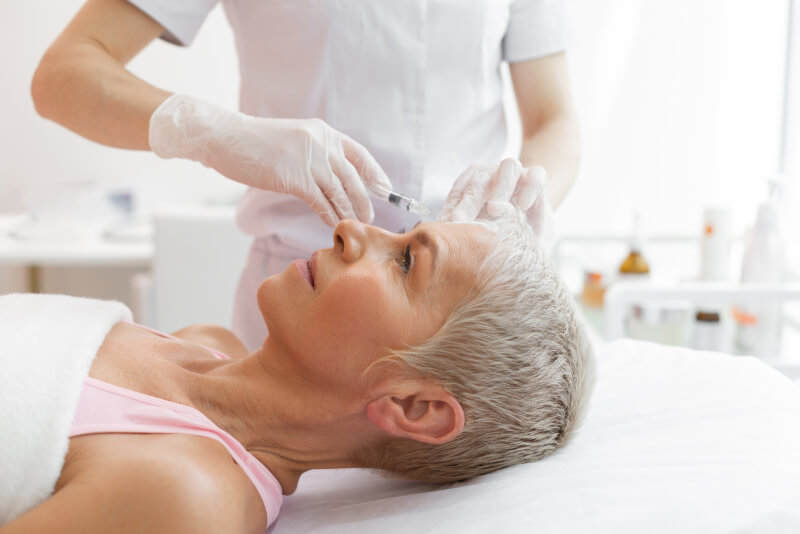Botox cosmetic injections are often the secret behind every celebrities’ younger-looking and wrinkle-free skin. With many success stories and beauty testaments affirming Botox’s fine work for reversing the signs of aging, it’s no wonder why many individuals are interested to try this injectable treatment for themselves. A common question that interested patients may ask is how many Botox injections should they get to clear their facial appearance from forehead wrinkles.
So how often should a patient receive Botox forehead treatments for optimal results? A Botox injection can last from three to four months, after which a patient can get new injections to maintain their results. According to your assigned treatment plan, your provider may recommend you to come back for maintenance injections once every three to four months.
Frequency for Botox Forehead Treatments

Botox forehead injections are popularly done to treat the glabellar lines or the horizontal wrinkles that appear across the forehead. It can also be given to treat the visible frown lines or the “11” lines that form whenever you crease your eyebrows.
The frequency of Botox forehead treatments that a patient receives will largely depend on the extent of their forehead wrinkles and fine lines. It’s crucial to know that Botox, also known as botulinum toxin, is a potent neurotoxin that is a purified form of the Clostridium botulinum bacteria. It’s been studied for years and has been approved for cosmetic injections for erasing crow’s feet and facial wrinkles.
When botulinum toxin injection is placed to the forehead muscles or frontalis muscle, it essentially works by blocking the release of chemical signals that cause muscle contraction. As a wrinkle relaxer, it limits facial muscle movement so that the facial lines and forehead wrinkles will smoothen and fade away for a period of time.
Most Botox patients receive their treatments every three to four months. This is because the effects of the botulinum toxin are not permanent and can only last for 10 to 16 weeks before they gradually wear off. Some patients may settle with receiving injections every 6 months.
One factor that affects how long Botox can stay is the fact that the body can produce new chemicals. Once the chemicals start circulating again, especially on the forehead muscles, the injections lose their blocking effects which makes it possible to contract the facial muscles again.
Botox results may also be affected by your facial expressions. If you’re an expressive person, you may find yourself constantly moving your face which can cause the toxin to spread and wear off faster.
How Many Units Of Botox Injections Are Given On The Forehead?
The number of Botox injections a patient will need to get varies on the skin condition or the severity of the forehead wrinkles and fine lines being treated. A consultation visit to your provider or a board certified dermatologist can help determine how many Botox units you’ll need to see desirable results.
When treating forehead wrinkles, one factor that a plastic surgeon or cosmetic provider may consider is gender. The reason for this is that men and women have different facial muscle characteristics. Individuals with thicker muscles on the forehead may need more Botox unit injections to ensure their efficiency on the face.
On average, women may receive 10 to 20 units on the forehead to treat their wrinkles and glabella lines. It’s recommended to administer four units of Botox per injection site across the treatment area for a successful procedure. Meanwhile, men may need at least 2 to 3 more units than females since they have stronger facial characteristics.
Another factor to consider is the age and how deep the wrinkles have set on the face. Wrinkles that form due to aging tend to be more severe especially since a person has lost some collagen to support the skin’s structure.
This is one reason why forehead wrinkles on older individuals tend to be deeper and more prominent, prompting them to have more frequent visits to their Botox provider. Younger individuals can still benefit from receiving low doses of Botox injections to prevent their wrinkles from getting worse.
Is Botox For Forehead Safe And How Long Does It Last?
Many clinical trials have been performed to guarantee the safety and efficacy of Botox for forehead treatments. It’s also approved to help treat conditions like overactive bladder, excessive sweating, chronic migraine headaches, cervical dystonia, and vision problems such as strabismus (crossed eyes) and blepharospasm (eye twitching).
The FDA highly recommends that the injections should be done under the expert hands of trained Botox injectors or licensed cosmetic professionals to assure effectiveness without any complications.
After your Botox procedure, you may need to wait for 14 days to see its full effects. The most common side effects that you may experience after the procedure are pain at the injection site, swelling, bruising, and tenderness. Receiving Botox at the forehead may also cause temporary headaches and muscle weakness. Just give your forehead muscles some time to adjust to the neurotoxin and the discomfort will go away on its own.
It’s also said that using Botox for long-term wrinkle treatments can have attractive benefits. Users who get regular Botox injections and have been treated for years may notice that their forehead muscles have been trained to limit their movement. Their muscles eventually become less prone to contraction and they may not need Botox injections as frequently as before. Long-term Botox can prevent the onset of severe wrinkles on the face and your years will not be as obvious on the face.
Botox vs Dermal Filler For The Forehead

When it comes to age-defying and wrinkle-correcting treatments, Botox and dermal fillers are the two cosmetic injectables that almost always come to mind. But as opposed to Botox which is a neurotoxin injection, dermal fillers are gel-like materials that are placed beneath the skin. Filler injections are commonly made of hyaluronic acid, a common skin care ingredient that helps hydrate and moisturize the skin.
Botox is primarily known for paralyzing the muscles to control facial movement which helps avoid the formation of unnecessary forehead lines, frown lines, and expression wrinkles. On the other hand, a dermal filler treatment essentially fills lines and wrinkles to restore fullness and volume to the face.
Dermal fillers are believed to be more efficient at addressing static wrinkles. These are wrinkles caused by the natural loss of collagen and elastin fibers which results in visible facial folds, lines, and skin laxity. Sun damage is one of the primary reasons for the collagen breakdown in the skin, causing premature skin aging. These wrinkles show even when a person is not moving their face.
Meanwhile, a Botox injection is a preferred treatment for dynamic wrinkles. This type of wrinkle tends to show more when an individual engages their facial muscles and creates different expressions. They are especially noticeable whenever a person laughs, smiles, frowns, or squints their eyes. They are also called expression lines, and these problematic wrinkles eventually become a permanent part of the face over time.
Forehead wrinkles, frown lines, and glabellar lines are usually identified as dynamic wrinkles. For this reason, a Botox injection is a more recommended treatment to minimize their appearance and prevent new ones from forming. Dermal fillers are more suited for facial rejuvenation of lost volume and restoring plumpness to facial features.
When Should You Actually Start Getting Botox?
Anyone can safely get Botox treatment as soon as they start noticing signs of aging like wrinkles on their face. Ideal candidates for a Botox cosmetic procedure are individuals who are at least 18 years old and above.
Dermatologists and skin doctors can recommend preventative Botox for the purpose of delaying the formation of deep wrinkles, folds, and lines. The suggested age for preventative Botox is the mid 20s to early 30s. This is because the amount of collagen produced in the body begins to decrease by 1 percent each year as soon as you reach your 20s.
Getting Botox in your early adulthood can reap benefits in the long run. In addition, your forehead muscles will be trained to restrict their movement so there won’t be any visible deep-set wrinkles as you get older. You will also generally need less Botox treatments in the future since you started early with the injections.
To ensure the safety and success of your early Botox treatments, always be sure to consult and get your injections from an experienced provider.
Get The Best Forehead Botox Treatments At Ethos Spa
Many people have already experienced the amazing wonders of Botox for erasing the signs of aging, restoring their wrinkle-free skin and their youthful complexion. If you’re looking for a non-plastic surgery alternative for skin rejuvenation, it is time to try Botox treatments at Ethos Aesthetics + Wellness.
Ethos Spa is a trusted Botox provider servicing clients in New Jersey and nearby areas. All procedures are performed by certified aesthetic professionals and trained cosmetic injectors that guarantee treatment success. Our doctors make customized treatment plans that address your specific concerns. To learn more about our Botox procedures, contact us today.







